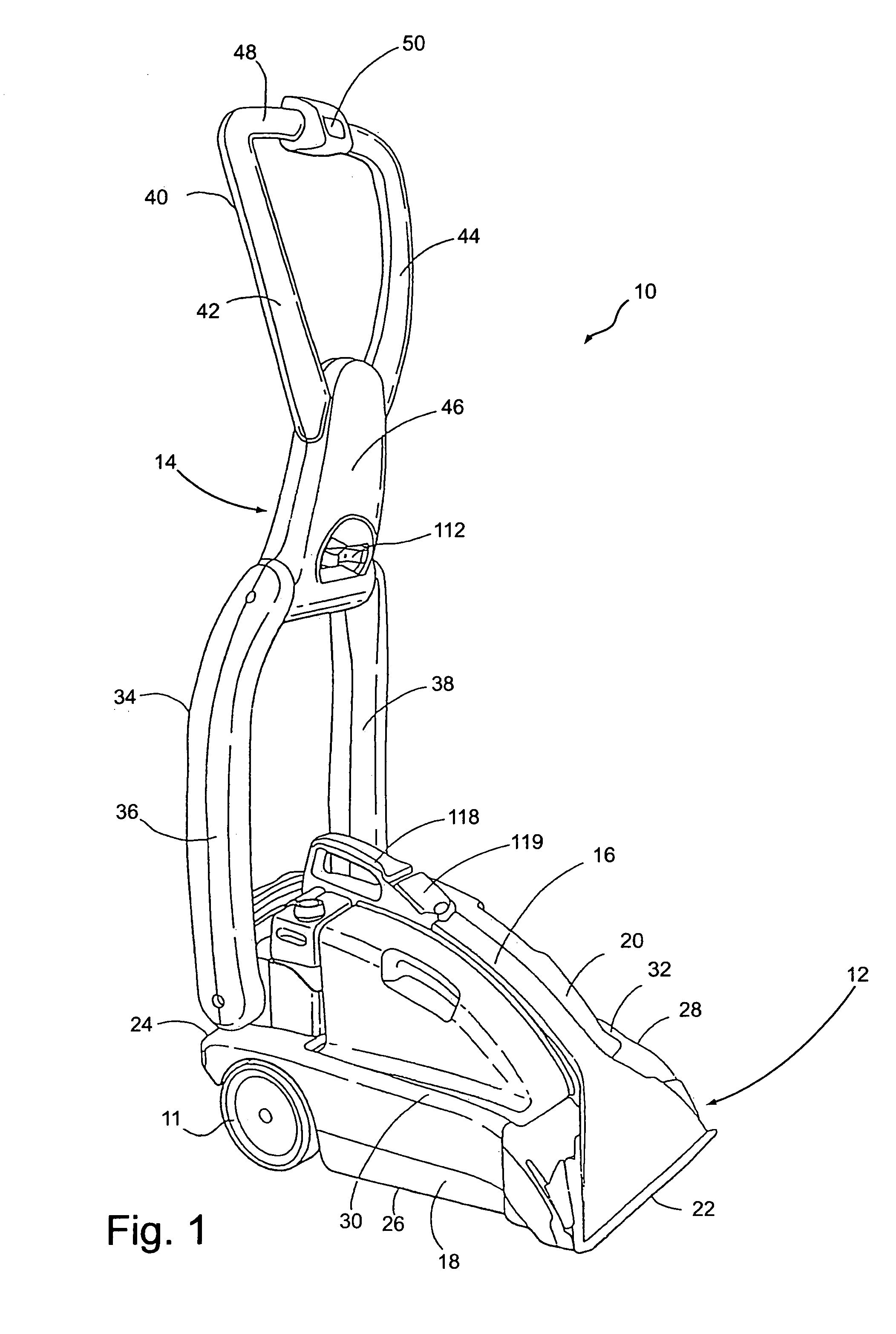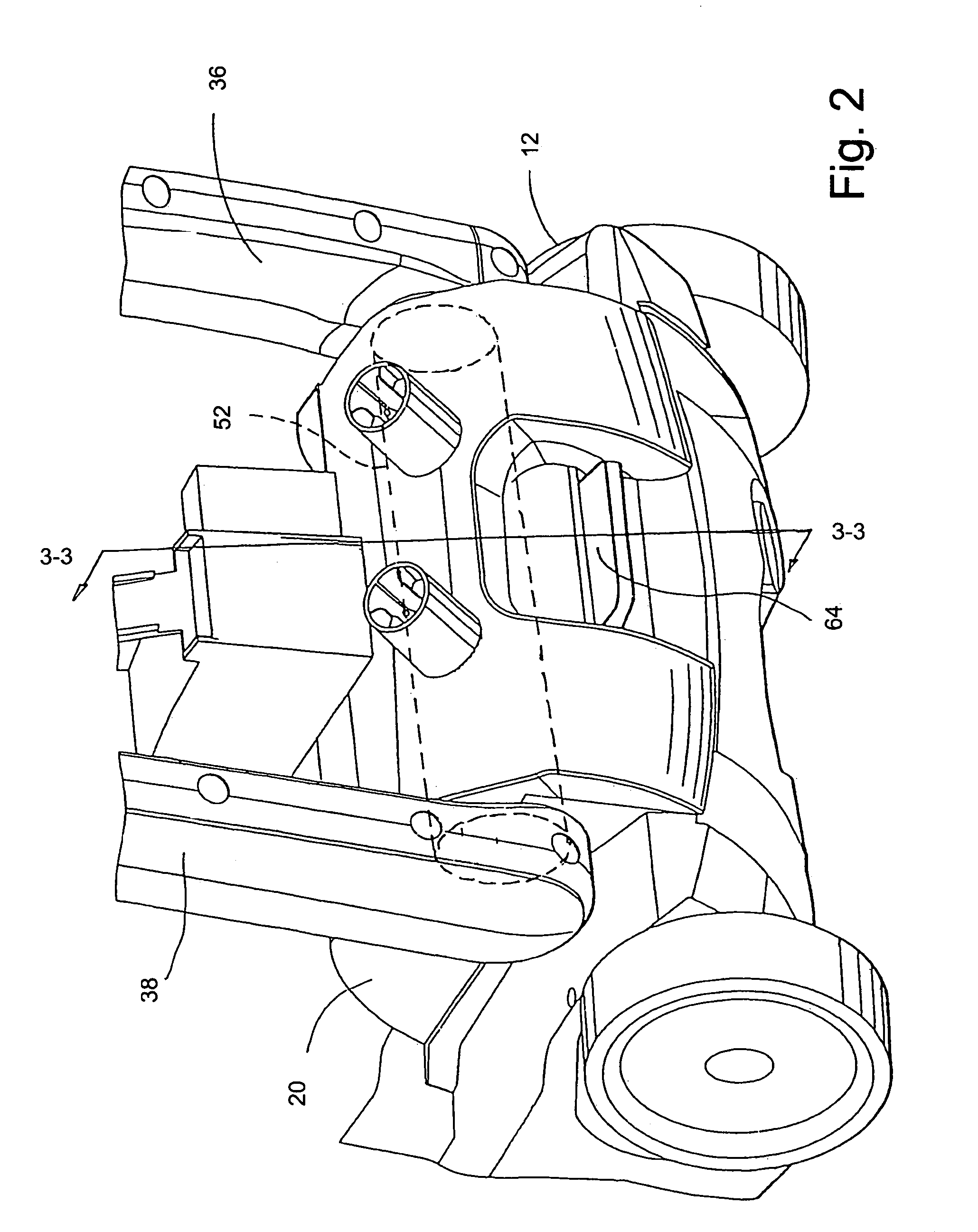The operating handle of conventional cleaning devices is not configured to facilitate compact storage, shipping, and / or transportation of the device.
Because the operating handle occupies a relatively large amount of space, its design is not ideal for compact storage.
Shipping is also problematic with conventional cleaning devices because their bulky shapes can not be fit into conventional rectangular shipping boxes without including a large amount of unused
air space in the box, which increases shipping cost.
While such disassembly reduces shipping costs, it is less desirable to customers, who typically prefer not to assemble the devices, may not be able to do so, and may find it inconvenient to disassemble the device for later storage, shipment and / or transportation.
Also, when the floor cleaning device must be transported from one location to another (e.g., up or down a flight of
stairs), a user must lift the device off the floor by the operating handle and carry the device in a relatively awkward position to the new location.
It can be appreciated that the bulky nature of the device makes this an undesirable task for many users.
Similarly, transporting the floor cleaning device in a vehicle (e.g., in a
trunk compartment) can be challenging for many users due to the difficulties in loading and unloading the device into and out of the vehicle.
This challenge is compounded by the fact that, in the case of wet extractors, users may wish to avoid tipping the device on its side to prevent water from escaping into the vehicle.
While this device is an improvement on traditional devices, the operating handle is only partially collapsible and thus continues to occupy too much vertical space.
While the collapsed operating handle of this device occupies a smaller amount of vertical space, a portion of the operating handle still extends laterally a considerable distance from the base assembly and thus occupies a larger amount of horizontal space.
As such, this design in not ideal for compact storage, shipping, and / or transportation of the device.
While the collapsed operating handles of these devices occupy a smaller amount of vertical space, substantial portions of the operating handles extend laterally from the base assemblies and thus occupy an even larger amount of horizontal space.
As such, these designs are not suitable for compact storage, shipping, and / or transportation of the devices.
While these devices also occupy less vertical space, the collapsed base assembly occupies an even larger amount of horizontal space.
Thus, these designs are also not suitable for compact storage, shipping, and / or transportation of the devices.
Furthermore, such devices require the operator to actually remove the handle, reverse it, and reinsert it into the device, which is inconvenient for the operator.
This design also limits the manufacturer's ability to place electric switches in the handle, which also inconveniences the operator.
Although a number of different wet extractors, supply tanks and recovery tanks have been produced, the prior art suffers from numerous shortcomings.
One shortcoming of prior wet extractors is the that the inlet nozzle often becomes coated or clogged by
dirt and debris removed from the surface being cleaned.
Because the nozzle profile is so narrow, it is difficult to clean using conventional means, and users must resort to cleaning the nozzle with
pipe cleaners and other specialized devices.
Another shortcoming of the prior art relates to supply tanks, which are typically difficult to fill unless a large sink or hose is available.
Furthermore, such a design may be difficult to fill unless the faucet can be swiveled out of the way to place the tank into the sink.
Such latches require additional manufacturing, are subject to breaking, are often not intuitively understood by users, making them difficult to operate, unhook and realign for reinstallation.
Similar problems are present with the supply tank of U.S. Pat. No. 6,073,300 to Zahuranec et al.
For example, the recovery tank disclosed in the '673 patent has a complex multi-chambered design that requires the incoming air / fluid mixture to
traverse a horizontal inlet that can easily
backflow when the vacuum source is turned off, causing waste fluid to seep back out onto the floor.
The recovery tank of the '673 patent is also inconveniently placed below the supply tank, and an operator must tilt the operating handle back and away from the upright resting position in order to access the recovery tank.
Such maneuvering is awkward to perform and risks toppling the device during recovery tank removal and
insertion.
Still another shortcoming of the '673 device is that the recovery tank float is located in a relatively large chamber, making it more subject to fluid sloshing and unnecessary vacuum
cut-off.
The complex structure of the '673 recovery tank also requires disassembly to drain, and is relatively expensive to manufacture.
Another shortcoming of the '475 recovery tank is that it requires a complex multi-piece construction in which the float is permanently sealed, increasing the cost of construction, making it difficult or impossible to service the float, and necessitating the inclusion of a separate drain plug.
Still further, the '475 recovery tank uses a pivoting tank handle, which requires additional material and construction effort, and is susceptible to breaking.
In addition to being a complex multi-piece structure, the '300 recovery tank is retained by a latch that requires additional material and construction effort, may be difficult to operate, and appears to be operable only when the operating handle is leaned back from the upright resting position.
Other prior art recovery tanks suffer from these and other problems.
Such devices suffer from being difficult to ship and store.
These configurations are also unduly complex, making them expensive to manufacture and difficult to operate.
Still further, such devices require more operator effort because the operator must bear the weight of the heavier operating handle when the wet extractor is at the end of the forward
stroke and the handle is tilted at its lowest angle relative to the ground.
Furthermore, the supply and recovery tanks of the '237 patent are contained in a single complex chamber having a flexible bladder, which is relatively difficult to manufacture, operate and clean.
Liquid management is a continuing challenge in the design of wet extractors.
Previous attempts to provide liquid management systems have entailed the use of complex, bulky and costly arrangements of pumps, valves, solenoids, switches and the like.
This requires additional construction material and limits flexibility in locating the priming assembly.
This also may cause some
delay between the time the pump is activated and the time that fluid is pressurized and available for depositing on the surface to be cleaned.
Furthermore, alternatives to mechanical valves in systems such as those in the '180 and '237 patents typically require the use of expensive electrically-operated solenoid valves to control fluid flow, such as shown in U.S. Pat. No. 6,513,188 to Zahuranec et al.
Another deficiency of prior art liquid management systems relates to the manner in which such systems are converted to operate in an accessory tool mode.
In many cases, such as in the '405 and '300 patents, the fluid hose hookup is also constructed as a complex and relatively expensive fitting that has a shutoff valve integrally formed with the fluid passage at the point of connection.
These systems are inconvenient and relatively difficult to use.
Although these devices conveniently use a single plug to attach the tool to a vacuum source and a fluid source, neither the '462 patent nor the '901 patent provides any way to divert vacuum and fluid flow from a floor-cleaning circuit to the accessory tool circuit.
Both of these devices also
pose electrical shock risks to the user due to the exposed electrical switch and terminals in the '462 patent, and the use of a separate electrical
plug in the '901 patent.
This risk is compounded by the lack of any sort of shutoff valve or anti-siphoning device for the fluid lines at or near the connection point.
The '098 patent also suffers from deficiencies as it relies on a coaxial design that is unnecessarily complex, and uses a complex shutoff valve that is integrally formed with the fluid passage at the point of connection with the accessory tool.
Such combined fluid passage / shutoff valves can be relatively expensive, and, because the valve is necessarily positioned at the point of contact between the parts, the valves are susceptible to being contaminated by
dirt and debris on the parts, which may impair the seal and result in leakage.
Other deficiencies of prior art liquid management systems relate to detergent mixing and metering systems.
(the '856 patent) uses a
complex system of hoses to pressurize the detergent chamber, and uses a rocker assembly to selectively pinch off the detergent supply hose, which can damage the hose and require more expensive hose material.
Although these devices have been used with some success, it has been found that they suffer from some disadvantages.
For example, they tend to spray fluids deposited by wet extractors, they accumulate
dirt (especially hair) and require constant cleaning and attention, and are subject to bearing and drive belt failure.
In addition, the aggressive sweeping of the bristles through the carpet or other surface being cleaned tends to cause accelerated wear of the surface, and may be unsuitable for delicate fabrics.
Like the horizontal rotating
brush design, this design is prone to accumulating dirt, and particularly hair.
Furthermore, it has been found that the counter-rotating vertical brushes of this
agitator tend to leave an undesirable streaked pattern in the
nap of some carpets, and, when used in a wet extractor, tend to leave corresponding streaks of unrecovered fluid on the surface being cleaned.
The aggressive sweeping of the bristles through a large path of travel is also believed to contribute to accelerated carpet wear and may be unsuitable for delicate fabrics.
Both of these agitators apply a significant
vertical force to the
brush, which is believed to contribute to accelerated wear of the surface being cleaned and tends to pound dirt and debris more deeply into the surface being cleaned.
These agitators (especially the '621 patent) are also believed to provide inconsistent cleaning due to the somewhat random movements generated by their drive systems.
Furthermore, these agitators are somewhat limited in their application because they rely on
turbine drives that can not be operated independently of the vacuum source.
However, this device also suffers from notable shortcomings, for example, the two reciprocating brushes do not fully cover the surface being cleaned, and therefore are believed to provide inconsistent cleaning.
Furthermore, the device is believed to cause accelerated wear of the surface being cleaned because the entire weight of the device rests on the
agitator brushes, and the brushes sweep through a relatively
large range of motion.
This device also fails to provide any vacuuming capability, and appears to be very difficult to operate on carpeted floors or other surfaces that would tend to hold the brushes and cause the
machine to move erratically.
These devices suffer from similar deficiencies.
 Login to View More
Login to View More  Login to View More
Login to View More 


